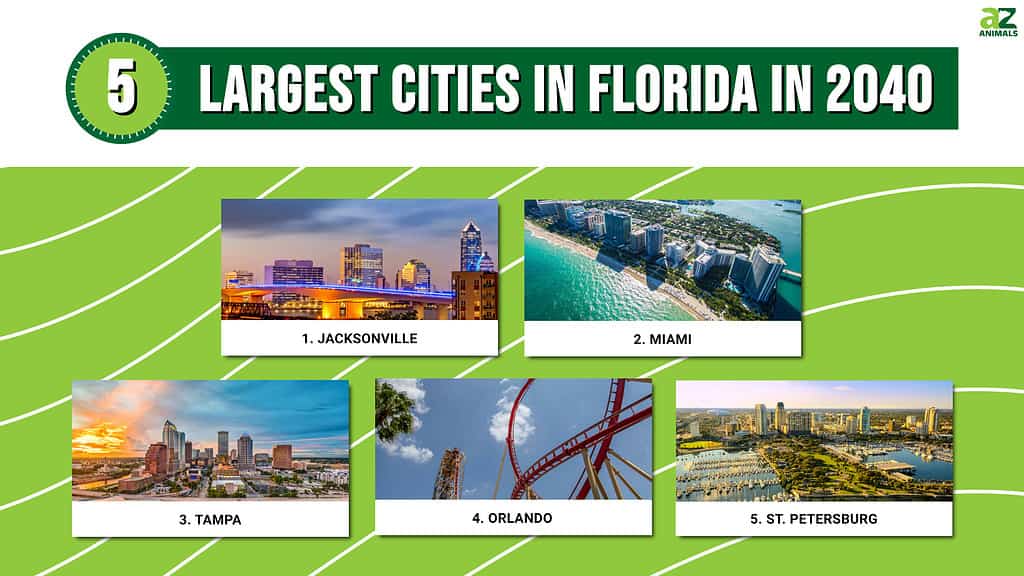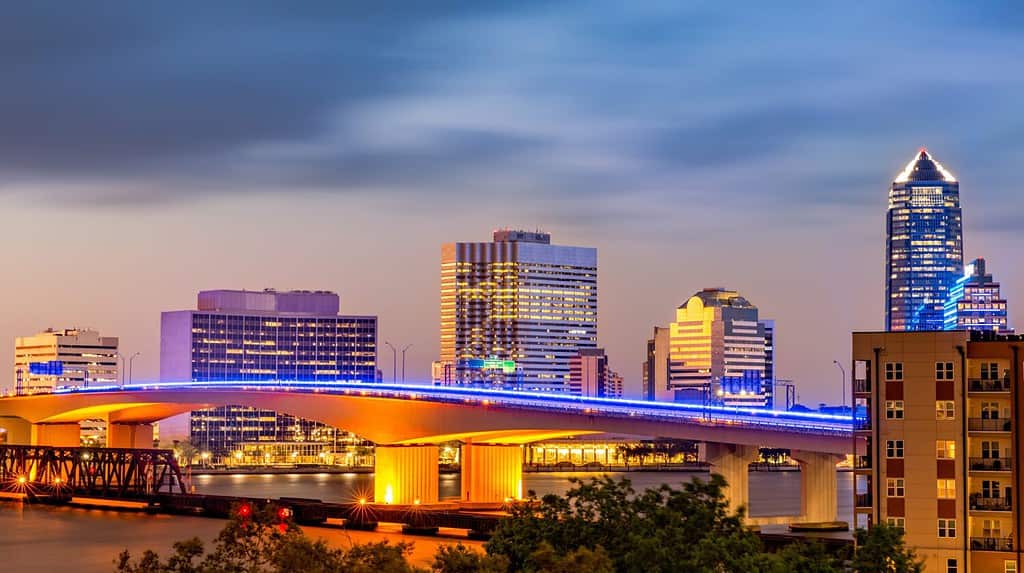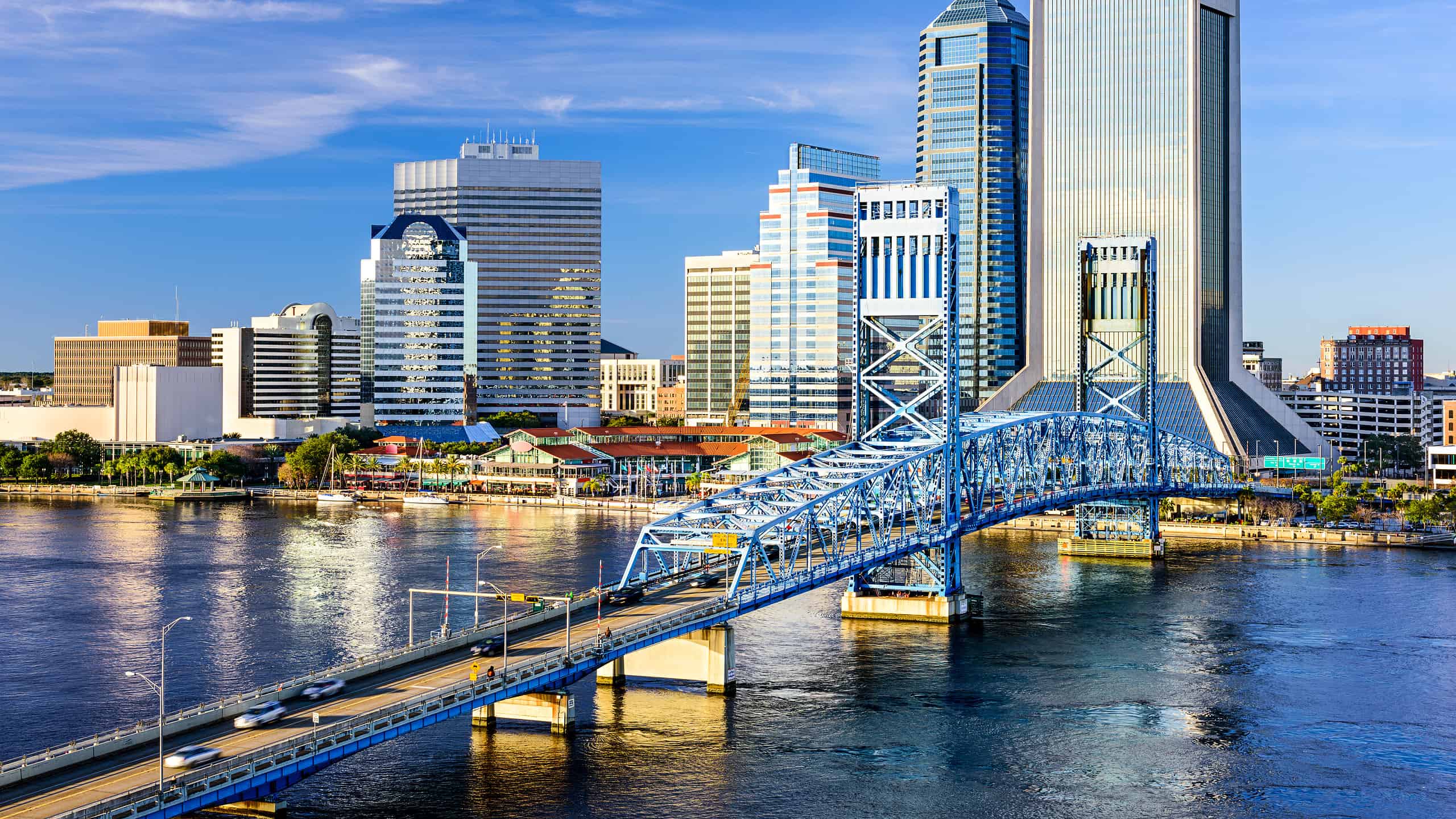Florida is experiencing a serious increase in population as many individuals move to Florida from other states. Population estimates regularly put Jacksonville as the largest city in Florida, with nearly a million people. By 2040, it will be easily above one million and likely stay the largest city in the state.
However, there are many cities that are also quite large, such as Miami and Tampa.
We can’t know exactly what population each city will have in 2040. However, population growth and the current population levels do give us some idea of which cities in Florida will be the largest in 2040.

Population growth and the current population levels of cities help to project what Florida’s future could be in 2040.
©
1. Jacksonville

Jacksonville is currently the largest city in Florida and will probably still be the largest in 2040.
©Mihai_Andritoiu/Shutterstock.com
Jacksonville is easily the largest city in Florida, and it will probably stay that way. It currently has the largest population in Florida of 949,611 according to the 2020 Census. This is largely because of its large land area. It covers 874.496 square miles, making it the second-largest city area in the contiguous United States after Anchorage, Alaska.
In 1968, Jacksonville and Duval County merged their governments and created a single entity. This consolidation is largely why Jacksonville is so large.
Furthermore, this country also benefits from its strategic location on the Atlantic coast, which draws in many people. It also straddles the St. Johns River, providing the city access to the ocean and inland waterways. It is a major port city for this reason. It’s also a regional hub for transportation, finance, and health care.
Jacksonville is known for its diverse and growing population. They have a mix of many ethnicities, races, religions, and cultures. This city has the country’s tenth-largest Arab population, for instance. They also have Florida’s largest Filipino American community. They also have a sizable African American and sizeable Hispanic community.
This community is expected to continue growing in the future. It attracts many residents due to its favorable climate and cultural amenities. The city is expected to expand by 32% between 2020 and 2040, increasing by over seven million people.
2. Miami

Miami is the second most populous city in Florida after Jacksonville.
©Mia2you/Shutterstock.com
Most people won’t be surprised that Miami is on this list. They have a large population of 442,241 people, according to the 2020 census. They’re the second-most populous city in Florida after Jacksonville and will probably remain that way.
Furthermore, Miami is the core of a much larger metropolitan area with a population of over six million. It’s the ninth-largest metro in the United States.
It has a larger population for many different reasons. Firstly, it’s located on the Atlantic coast and has a natural harbor, making it a center for trade and tourism. The city is known as the Gateway to the Americas and has one of the largest concentrations of international banks in the United States.
The city’s climate and culture attract many different people. It has a sizable Hispanic and Latino population. In fact, these populations make up 70.2% of the city’s population. The city also has a vibrant art and entertainment scene with regular festivals.
Miami’s history has shaped its growth. This city was founded by Julia Tuttle, a wealthy widow who convinced the very wealthy railroad tycoon Henry Flagler to extend his line to the area in 1896.
Since then, Miami has seen several waves of immigration, including Cubans, Haitians, and Venezuelans.
3. Tampa

Tampa’s climate has contributed to its rapid growth in population, which is expected to continue into 2040.
©iStock.com/Sean Pavone
Tampa has a population of 384,959, according to the 2020 census. It’s the third-largest city in Florida. However, it is part of a larger metropolitan area that’s known as the Tampa Bay Area, which has a population of just over six million.
It’s in a location on the west coast of Florida near the Gulf of Mexico. This makes it a stunning center of trade and tourism, especially given its climate. It’s known for its attractions, including the Florida Aquarium and the Lowry Park Zoo.
Its climate has attracted many different people. Its subtropical climate attracts many tourists and residents, leading to quick population growth. It has a bright and vibrant entertainment scene, with many museums and theaters.
Tampa was initially inhabited by indigenous people of the Safety Harbor culture, including the Tocobaga and the Pohoy. It was explored by the Spanish in the 16th century and was abandoned until the U.S. acquired Florida from Spain in 1819.
This city became an important military center during the 19th century. The cigar industry was also brought into the city. Since then, the city has had several waves of immigration.
4. Orlando

Orlando is known as the Theme Park Capital of the World.
©Box Lab/Shutterstock.com
Orlando has a rather large population of 307,573 according to the 2020 Census. It’s also part of a decently large metropolitan area of 2 million. It’s the 23rd-largest metro area in the country, making it less populous than other areas.
This city is located in central Florida and is known for being the Theme Park Capital of the World. It has several famous parks, including Walt Disney World, Universal Studios, SeaWorld, and Legoland. It also has a rather large international airport that connects it to many different areas.
Its subtropical climate with mild winters attracts many people. It has a diverse population full of people of Hispanic, African American, Asian, and European descent. Orlando has a vibrant entertainment scene with lots of theaters and sports venues.
Initially, Orlando was inhabited by people of Timucua and Seminole tribes. The area wasn’t settled by European settlers until it was acquired by the United States in 1821. The city’s name is derived from Orlando Reeves, who was a soldier that died in the area in 1835.
5. St. Petersburg

St. Petersburg has a population of 258,308, making it the fifth-largest city in Florida.
©iStock.com/SeanPavonePhoto
St. Petersburg has a large population. According to the 2020 census, St. Petersburg has a population of 258,308. That makes it much smaller than some of the other cities on this list. However, it is the fifth largest city in the area.
This city is located on the west coast of Florida and is a major center of trade. It has a large port and downtown waterfront, allowing it to attract many visitors and businesses. It’s also known for its cultural attractions, including the Museum of Fine Arts and the Florida Orchestra.
Like many cities in Florida, many people are attracted to this city because of the subtropical climate. It has mild winters and hot summers, which has led to a diverse population in the city.
The area where this city now sits was originally explored by the Spanish in the 16th century. However, it wasn’t settled until the United States acquired the area. It was founded by John C. Willians and Peter Demens. Demens named it after his birthplace in Russia.
Summary of the 5 Largest Cities in Florida in 2040
Here’s a recap of the five Florida cities that are projected to be the largest in the state by 2040.
| Rank | City | Population (2020 Census) |
|---|---|---|
| 1 | Jacksonville | 949,611 |
| 2 | Miami | 442,241 |
| 3 | Tampa | 384,959 |
| 4 | Orlando | 307,573 |
| 5 | St. Petersburg | 258,308 |
Thank you for reading! Have some feedback for us? Contact the AZ Animals editorial team.








